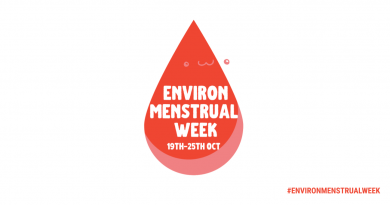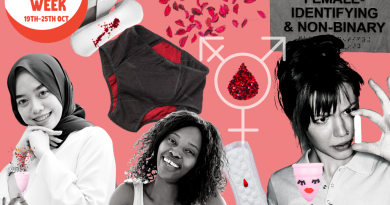If we don’t set a dream out, we don’t know where we’re headed
In an interview with Hailey Morton, a HEJSupport intern, Dr. Ann Blake, founder of Environmental & Public Health Consulting, shared her vision of what the future of sustainable menstruation should look like.
Interviewer: Hi Ann, thank you for agreeing to this interview. You got a PhD in molecular genetics and neurodevelopment. However now you focus mainly on green chemistry. What was the reason for such a change in you career?
Ann Blake: My science degree opened a lot of possibilities. After getting a PhD I joined California EPA (Environmental Protection Agency) as a Hazardous materials (Hazmat) inspector. However, I have always been looking at how systems work, from fruit fly development to Hazmat inspection. As a Hazmat inspector I was looking at the end of the pipe, at residual contamination, and saying, ‘Wait, this makes no sense. Why are we dumping all of this stuff?’ This was an expensive material that you’d pay for upstream, and now you’re paying for it getting it out of the environment. In retrospect I think of it as moving up the pipe and saying, ‘What else can we do to make this work better?’ Solutions including process efficiency and pollution prevention. That’s how I ended up where I am now in the green chemistry world. The idea is to make less stuff, but when you make stuff, make it as safe as you can.
Interviewer: That’s quite the career trajectory though; very interesting. What are the primary projects or initiatives you are currently working on with Environmental and Public Health Consulting?
Ann Blake: I’ve been an independent consultant for 18 years or so. Initially, when I became an independent consultant in 2002, my first work was on flame retardants, which we then ended up getting on the POPs (Persistent Organic Pollutants) list when the POPs convention was signed. I have to work at multiple levels because the stuff at the international level, you can only check in every decade or so to see if there’s any progress. I leave the national stuff in the US to other people because the policy just frustrates me too much. So, I work at the state level, because in California, the work we do does change the market.
I’ve also worked with cities; I’ve worked with just about anybody who will work on making safer materials and safer chemistry. It started out with cities, [including the] City of San Francisco, City of Seattle, as well as the state of Hawaii, pushing for safer cleaning chemicals for worker exposure. Other priorities have been empowering immigrants, particularly immigrant women, who tend to take low barrage entry jobs and get high chemical exposure, with no protection. So that’s in environments such as house cleaning, hotel cleaning, [and] nail salons, among others. And then we also began to examine women’s disproportionate exposure to things like feminine care products, which are not tested for safety as an internal device. They’re considered to be an external medical device, which makes no sense. They are clearly created by people who are unfamiliar with the female anatomy.
So initially my drivers were folks like the City of San Francisco when they implemented the Precautionary Principle and redid their environment code in 2003 or so. And then all the NGOs left and said, ‘Okay, we’re done’, and the city of San Francisco said, ‘Wait, what do we do now? What does this mean?’. So, I was part of a team of consultants that helped figure out what the Precautionary Principle meant for a city.
Then over time, I had companies come to me, so I started working with Costco last year. I’ve worked with Disney [and] Walmart with some colleagues, all with very different approaches. There are 100,000 Walmarts with 100,000 products on any given store shelf – What do I do? Where do I start? We help companies with that. And then over the last few years I’ve worked with NGO coalitions a lot on various different things. I tend to work with NGOs that are science-based.
Interviewer: In your work consulting with major corporations (such as Costco), do you think there has been an increasing willingness to adopt green chemistry and environmental initiatives in the retail sector in recent years?
Ann Blake: Yes, absolutely; and there’s been some very targeted efforts on that front as well. Within Green Chemistry & Commerce Council, my colleague Sally Edwards has been working with retail leadership. One of the things that they were able to do (I wasn’t part of this I just think it’s amazing work) is to bring major retailers together with chemical companies, because what we see is that the supply chains are so complex that the message will get lost. Consumers will say, ‘Oh, we want non-toxic products’, but by the time it gets to the company that makes it, they’ve lost the impact of that message. The retailers get that first from consumers, so bringing retailers and companies together is important saying, ‘These are the things we’re hearing from our consumers, what are you going to do about it’?
Interviewer: On our Plastic and Toxic Free Period site, there is a lot of information on the lack of transparency in the feminine hygiene product industry surrounding ingredient disclosure, while many of these products contain chemicals with potentially adverse impacts on human health. Do you think there are any improvements that should be made to the regulatory process regarding how menstrual and feminine hygiene products are approved for the market?
Ann Blake: I’m not sure how to identify the challenges there, it’s wrapped up in some persistent cultural challenges. These are challenges that exist also in the research-science world, which is that men are considered to be the default and women are weird and hard to study. And so there’s a general lack of awareness about chemicals in products, and then there’s the more immediate stuff about how it’s considered as a medical device. How it’s categorized by the FDA as a medical device is completely absurd. Particularly in the US around personal care products, when you look at food, drug, and cosmetics regulations, you have 2 pages on cosmetics, whereas the European Union has banned 1200 chemicals the Japanese have banned the equivalent amount. The US is hopelessly behind on that, and so I think there’s a misogyny built in there, that we have to make people aware of. That’s reflected in research. And we don’t have adequate research about how these exposures impact among the most absorbent tissue in a woman’s body. So, all of that needs to be dealt with, some of it maybe needs to be regulatory. The Office of Women’s Health Research at the CDC is a fairly recent thing. There’s still this daunting awareness that women are different, they need to be studied, their risks are different. I mean [the disparities are] so persistent in this day and age. And we’ve encountered that with other personal care products that are very harmful to women around the world, like mercury iodide-based skin lighteners. There’s a cultural stigma in this case around periods, generally. I mean we still have… women and girls who can’t go to school or work when they bleed because they don’t have access to any kind of period products. I believe policy and regulation are some of the process, but we still have a lot of outdated cultural norms. Where do you poke at the system to make it shift?
Interviewer: What do you think the future of sustainable menstruation should look like?
Ann Blake: Well we just laid out all the challenges. One I think that I would say is the stigma removed globally around periods and [women being able] talk about our bodies. I think all women should have access to safe, nontoxic, preferably renewable or regeneratively created menstrual products that are comfortable. All of those pieces – so there’s no body stigma, that we have adequate research about the impacts of chemicals on our bodies from these products, that all women have access, and that they’re safe, nontoxic, and don’t pollute the environment.
Interviewer: That’s a great response.
Ann Blake: Easy, short response. Harder to implement. Well if we don’t set a dream out there, we don’t know where we’re headed.
Interviewer: Where can our readers go to find out more about your work?
Ann Blake: Probably my website, http://www.annblake.com/ which I need to update. I am shifting more toward the climate world so I’m working on the intersection of climate, health, toxics, and equity, and what I’m looking for is – how do we build a materials economy that’s not toxic in any of the ways we’re concerned about – not toxic from a chemical point of view, not part of the extractive economy. So, I think we’re looking at local regenerative economy. The work I’m doing and don’t have much up yet about on my website is – what does it look like to have an economy that’s not based on fossil fuels, and how do we make the stuff that we need in a way that is equitable and doesn’t have disproportionate impacts on poor people, people of colour?
Interviewer: Thank you so much for taking the time to interview with me today.



